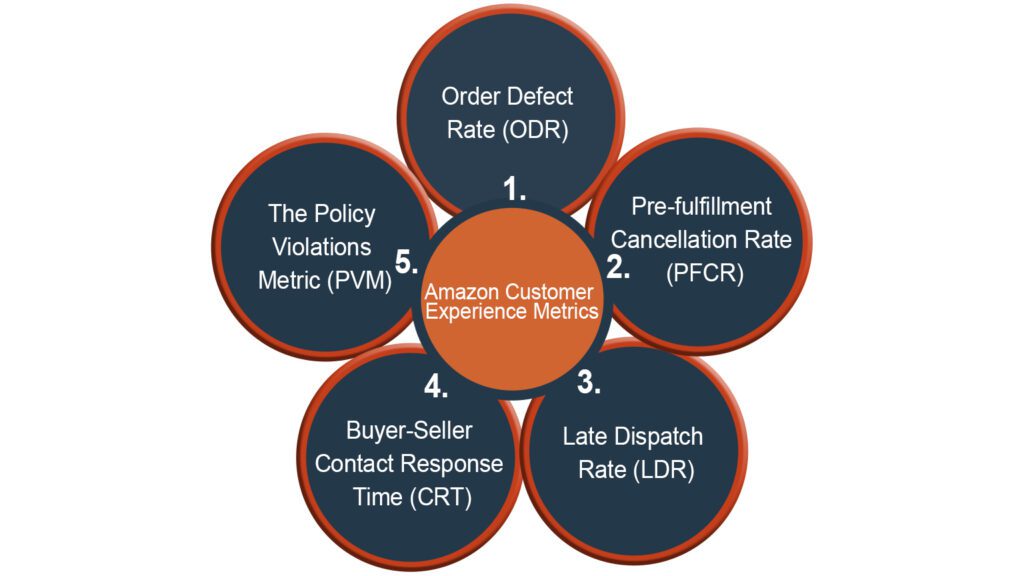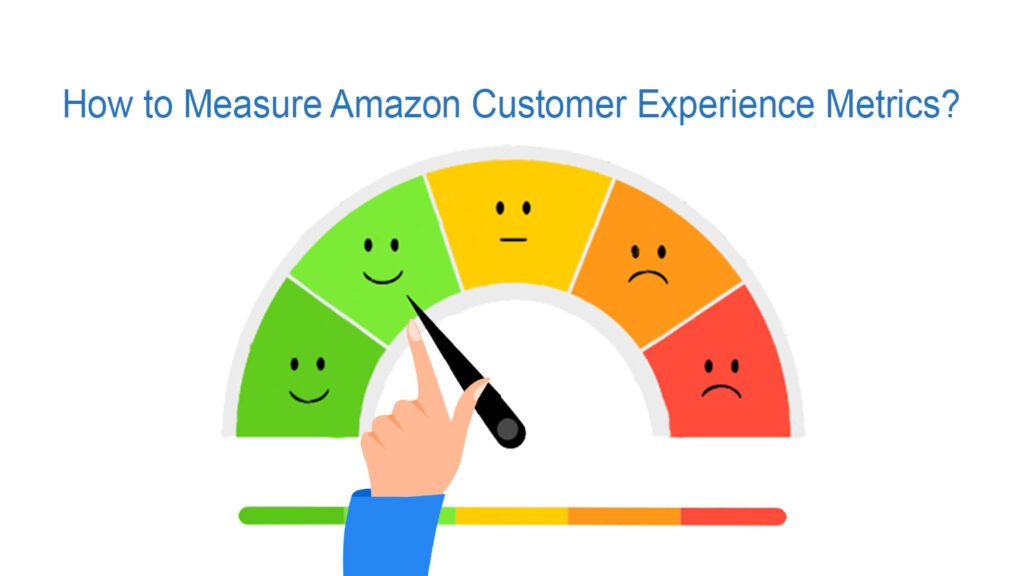
What is Amazon’s Customer Experience Metrics?
Amazon Customer Experience Metrics are a set of indicators that showcase your company’s customer experience program rate and customer satisfaction. Every customer interaction with your company impacts the customer experience for you.
Customer Experience Metrics help Amazon sellers to improve the shopping experience of their customers and identify possibilities to optimize their product listings. These metrics ensure that sellers meet the high expectations their customers demand from them. These metrics are also used by sellers as a quality control tool. Sellers can track various aspects of customer experience and get insight into whether their customer experience is the best, average, or poor. Our blog has all the answers if you don’t know which metric you should pay attention to first.
Types of Amazon Customer Metrics

Since there are many touchpoints in the customer journey, you need to understand which key performance indicators (KPIs) are the most important to determine how well your Amazon business is performing, in comparison to your goals. Below are the crucial Amazon metrics explained and you should be tracking them.
1. Order Defect Rate (ODR)
Your Order Defect Rate (ODR) is the number of people who had a negative experience with you. An order is considered defective by Amazon if:
- An A-to-Z Guarantee claim is made
- A customer makes a credit card chargeback
- A negative review is left by the customer
The ODR is calculated by dividing the number of defective orders by the total number of orders throughout the period. As the negative reviews, chargebacks, and returns in your account increase, the customer will start losing faith in you. It will impact your order defect rate (ODR) and result in fewer sales.
Amazon has set a target of <1% failure for the ODR metric
A target of less than 1% seems harsh and perhaps a little daunting, however, if the product you sell is accurately described, and well packaged and you always respond to customers quickly you shouldn’t have any difficulty meeting this target.
2. Pre-fulfillment Cancellation Rate (PFCR)
The percentage of canceled orders by the seller before shipment is known as PCFR. It is the seller’s responsibility to ensure that they have the inventory available that they are advertising for sale. If a customer places an order and the seller cancels that order because they do not have the stock, this is known as a pre-fulfillment cancellation. The customer is not at fault since the seller cancels the order.
Your cancellation rate needs to be less than 2.5% to meet Amazon’s PFCR target.
The number of cancellations divided by the number of orders in the same period that stay below 2.5% is PCFR. If you do this often, your pre-fulfillment cancellation rate will rise. Managing stock is a vital responsibility for every seller. Amazon automatically updates your stock levels when a customer purchases. Hence, check your inventory list regularly.
3. Late Dispatch Rate (LDR)
The percentage of your orders that are late dispatched is known as the LDR metric. According to Amazon, an order whose shipment confirmation is overdue by three or more days is a late order. Remember to tell Amazon every time you ship out an order!
From a customer’s point of view, there is nothing worse than receiving an order past its expected delivery date. Late shipment prompts poor reviews, so on-time shipping is crucial to ensure customer satisfaction. Keep your late shipment rate below 4%, and ensure that you continue to provide on-time shipping for your customers.
The LDR should be less than 4% to meet Amazon’s target.
Always between 7 to 30 days, this metric is calculated. If your late shipment rate is approaching 4%, Amazon sends you a notification.
4. Buyer-Seller Contact Response Time (CRT)
Your CRT measures the number of messages you’ve replied to within 24 hours. Amazon expects you to respond to messages within 24 hours, so you must regularly check your messages. It also doesn’t matter what day of the week a customer contacts you, even on weekends you have to reply to customers. Amazon notifies you by email if any customer messages are waiting for your reply in your Seller Central Account.
Being unresponsive will negatively affect your metrics, so make it a priority to answer queries quickly as possible. With customer service like this, you will achieve more sales.
Amazon demand that every seller replies to a customer within a 24hr period, failure to do so will negatively affect the CRT metric.
5. The Policy Violations Metric (PVM)
If you violate any Amazon policies or drop below its selling thresholds, you will receive a notification within your Seller Central account. Be sure to regularly check your ‘Performance Notifications’, which are in the performance section of Seller Central.
A green tick means you have no unread notifications or performance notices and a yellow exclamation mark means you have performance notices to read. If you see a big red cross, your account is under the scrutiny of Amazon. So check your performance and notifications instantly.
Why It Is Necessary to Understand Customer Experience KPIs?
Now offering the finest product at the lowest prices is not enough. Today, customers know that if they’re not feeling appreciated or respected, they have other options to find these services. To secure the longevity of your business, you’ll need to keep an eye on those Customer Experience (CX) KPIs.
Increase Brand Loyalty: Companies can ensure that their satisfied customers remain that way through special promotions and programs. Not only will this help keep them around, but it can also turn them into brand supporters who regularly recommend your product or service to others.
Turn Passives into Promoters: Passives may be indecisive about your company. With a little extra TLC, these passives may be able to be converted into promoters who will help you grow your business.
Avoid Negative Comments: You can persuade known detractors not to leave brand-damaging comments about your products as reviews.
Improve & Deliver Customer Service Consistently: From handling times to problem resolution time, make improvements with the help of CX KPIs. If some of your customers are highly satisfied while others are dissatisfied, CX KPIs may be able to fill in the gaps to determine why there are such mixed opinions regarding your service.
Tips for Measuring Customer Experience

Now start collecting customer experience metrics of your own. Here are a few things to keep in mind when measuring CX.
1. Get Real-Time Results
You know you cannot ask someone about their new product before it ships. The best time to ask for customer feedback is when their experience is fresh. If you extend, they may not recall what made the interaction positive. Asking for feedback immediately after a transaction is the best way to get a genuine and precise response.
2. Consider Survey Questions
CX surveys are a great way to collect customer feedback but do not take their time for granted. Surveys should be quick and only ask the most important questions. Otherwise, if you abuse their time, they may want to drop out during the survey and answer questions inaccurately just to be done with it or ignore it altogether.
3. Map the Customer Journey
Create a visual story of your customer interactions with your brand so that the business leaders can put themselves into their customer’s shoes and see things from their perspective. It also helps determine when you want to ask for feedback and how you go about it.
4. Check Other Sources of Customer Feedback
While surveys, pop-ups, and other methods you use to obtain feedback are great, do not forget to check out the feedback that already exists elsewhere! That means looking at third-party sources like online review sites, social media posts, etc. for better CX strategies.
5. Make Use of All Feedback
Make sure you utilize all the feedback, getting it to the right people within your company who can help you with these and pass along the findings so the company can take further action.
6. Don’t Overmeasure
Companies need to collect CX metrics appropriate to their business. Never ask for customer feedback if you do not know how to act on it. Many brands gather the metrics but do not understand how to get value out of these metrics.
7. Connect the Dots
CX KPIs can influence many departments in a company, such as marketing, sales, customer service, R&D, etc. You can connect the dots between what customers want and how it affects various departments. The results of these metrics can be far-reaching!
8. Focus on the Future
It is beneficial to understand the reason you are losing customers. Progressive marketing measurement can help you learn. Being ingenious with CX measurement results aids in customer retention, building loyalty, and more. Tracking the marketing, sales, and inventory metrics will help you regulate the overall costs of the business.
Final Thoughts
Looking for a Customer Experience Metrics Expert? Let SIPRANSHECOMMGROWTH measure the most common CX metrics & KPIs, foster loyalty, and drive growth for your business. We have expertise in Amazon SEO, EBC Services, and Seller Account Audit Services with Account Management Services for your seller central. Let us be your guide now.






